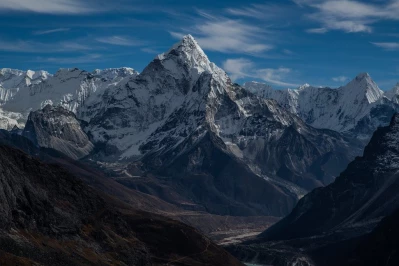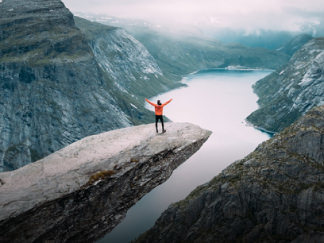
Best Time to Visit Nepal for Trekking: A Season-by-Season Guide for Adventurers
- 1. Detailed Breakdown of Trekking Seasons in Nepal
- 2. Additional Considerations for Choosing the Best Time to Trek
The majestic Himalayas beckon adventure seekers from across the globe. Nepal, the land of Everest, offers a trekker's paradise with diverse landscapes, challenging climbs, and breathtaking views. But before embarking on your Himalayan adventure, choosing the right season is paramount. Weather conditions, accessibility, and personal preferences all play a crucial role in shaping your trekking experience. This guide delves into the best time to visit Nepal for trekking, equipping you for an unforgettable journey.
1. Detailed Breakdown of Trekking Seasons in Nepal
Now, let's delve into a detailed breakdown of the trekking seasons in Nepal, highlighting the pros and cons of each for your adventurous spirit:
1.1 Spring (March - May)
- Weather: Spring offers a delightful blend of comfort and beauty. Temperatures are pleasantly warm during the day, with cool nights. Clear skies are prevalent, making for stunning vistas. The highlight of spring is undoubtedly the explosion of wildflowers that paint the landscape in vibrant hues.
- Pros: Spring provides comfortable trekking conditions with breathtaking scenery. The trails are relatively dry, making for easy navigation. This season is ideal for those who prefer moderate temperatures and fewer crowds compared to the autumn peak.
- Cons: Some high-altitude trails might still have lingering snow from the winter, requiring extra caution. Spring can also experience unpredictable weather changes, so be prepared for occasional rain or snowfall.
- Recommended Treks: Spring is a fantastic time for lower-altitude treks like the Annapurna Base Camp trek (consider late spring to avoid any remaining snow) or the Langtang Valley trek. If you're well-acclimatized and comfortable with colder temperatures, the lower sections of the Everest Base Camp trek can also be attempted during this season.
>>> Read more: Differences Between Trekking And Hiking? Which One is Right for You?
1.2 Summer (June - August)
- Weather: Summer is the warmest season in Nepal, with lush greenery and vibrant wildflowers blanketing the lower regions. However, this is also the monsoon season, which starts in mid-June. While some regions experience only brief afternoon showers, others receive significant rainfall, leading to landslides and trail closures.
- Pros: The lush greenery of the monsoon season creates a spectacular natural display. Summer generally receives fewer crowds compared to the autumn peak season, except for the very beginning of June before the monsoon hits.
- Cons: Monsoon rains can significantly disrupt your trek. Trails become muddy, visibility is reduced, and landslides are a potential risk. High-altitude treks become inaccessible due to heavy snowfall and treacherous conditions.
- Recommended Treks: Due to the monsoon, high-altitude treks are not recommended during summer. However, lower altitude treks like the Poon Hill trek or the Mardi Himal trek can be attempted in the early part of the season when the monsoon rains haven't arrived.
1.3 Autumn (September - November)
- Weather: Autumn, often referred to as the "golden season," is widely considered the best time to visit Nepal for trekking. The monsoon rains subside, leaving clear skies with stunning mountain views. Temperatures are pleasantly cool during the day and comfortably cool at night.
- Pros: Autumn offers ideal trekking conditions with minimal rain, clear skies, and comfortable temperatures. This season boasts stunning fall foliage in some regions, adding to the visual appeal. The stable weather makes it the most predictable and reliable time for trekking, especially for high-altitude treks.

- Cons: Autumn is the peak trekking season in Nepal, attracting the highest number of tourists. Popular treks like Everest Base Camp and Annapurna Circuit can get crowded, and booking permits and accommodations well in advance is essential. Prices for flights and accommodations might also be higher during this season.
- Recommended Treks: Autumn is the ideal time to tackle high-altitude treks like Everest Base Camp, Annapurna Circuit, or any trek that ventures into the higher Himalayan regions. The stable weather and clear skies make it the most rewarding time for these challenging journeys.
>>> Discover more: Nepal must know before travel
1.4 Winter (December - February)
- Weather: Winter is the coldest season in Nepal, with snow blanketing the higher regions. Temperatures can drop significantly, especially at high altitudes. While some lower valleys experience mild weather, winter generally sees minimal rainfall or snowfall in the lower regions.
- Pros: Winter offers a unique trekking experience for those seeking adventure off the beaten path. The dramatic snow-capped peaks create a breathtaking landscape, and the trails are significantly less crowded compared to the peak seasons.
- Cons: The extreme cold temperatures can be challenging for even seasoned trekkers. Many high-altitude treks become inaccessible due to heavy snowfall and require special equipment like crampons. The limited daylight hours can also restrict your daily trekking time.
- Recommended Treks: While high-altitude treks are generally not recommended during winter, some lower-altitude treks in the foothills like the Langtang Valley trek can be feasible for experienced winter trekkers. Some regions might offer shorter teahouse treks during this season, but thorough research and proper winter gear are crucial.
2. Additional Considerations for Choosing the Best Time to Trek
- Festivals and Cultural Events: Nepal boasts vibrant cultural festivals throughout the year. Dashain and Tihar, the biggest festivals, typically fall in September or October, coinciding with the peak trekking season. While experiencing these festivals can be a unique cultural immersion, it can also lead to higher prices and crowded trails, both on the treks and in the towns.
- Personal Preferences: Ultimately, the best time to visit Nepal for trekking depends on your individual preferences. Do you prioritize comfortable temperatures and clear skies over crowds? Are you willing to brave colder temperatures for a less crowded experience? Considering your tolerance for heat, cold, and crowds will help you choose the ideal season for your adventure.

Nepal, with its majestic Himalayas, offers a trekker's paradise year-round. Each season presents unique advantages and challenges. By understanding the weather patterns, trail conditions, and crowd levels associated with each season, you can make an informed decision about the best time to visit Nepal for trekking. Remember, the right season can make or break your trekking experience. Choose wisely, pack for the elements, and prepare yourself for an unforgettable adventure amidst the awe-inspiring beauty of the Himalayas.
Contact Adventure Asia today and let our Nepal experts design your dream trek. From conquering Everest Base Camp to exploring hidden valleys, we'll help you craft an unforgettable adventure that pushes your limits and leaves you yearning to return to the land of the Himalayas.





















